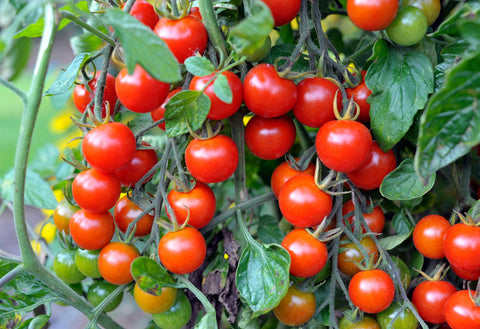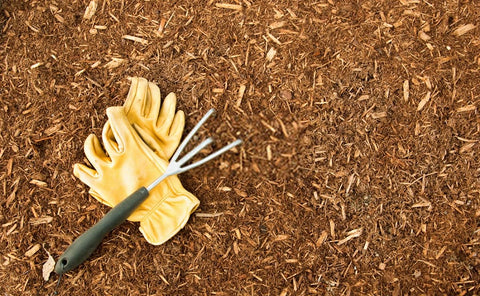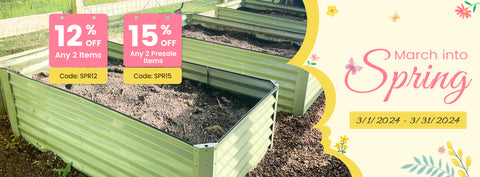Introduction
Growing fruits at home is not only a rewarding endeavor but also a delightful way to connect with nature and enjoy the freshest, most flavorful produce right from your backyard. In this comprehensive guide, we'll explore everything you need to know to start and maintain a fruitful garden of your own.The following content also has some reference value for raised garden beds.

Benefits of Growing Fruits at Home
Freshness and Flavor
There's nothing quite like the taste of freshly picked fruits from your garden. Unlike store-bought produce that may travel long distances and undergo various handling processes, homegrown fruits are picked at the peak of ripeness, ensuring maximum flavor and nutritional value.
Cost-Effectiveness
Growing your own fruits at home can also save you money in the long run. While there may be initial investments in seeds, tools, and soil amendments, the cost of maintaining a fruit garden is generally lower than continually purchasing fruits from the grocery store. Plus, the satisfaction of harvesting your own produce is priceless.
Environmental Impact
By growing fruits at home, you can reduce your carbon footprint and contribute to environmental sustainability. Home gardens require fewer resources for transportation and packaging, resulting in lower greenhouse gas emissions and less waste. Additionally, organic gardening practices can minimize chemical inputs and promote biodiversity in your local ecosystem.

Choosing the Right Fruits to Grow
Consider Climate and Growing Conditions
Before selecting fruits to grow in your garden, it's essential to assess your local climate and growing conditions. Different fruits thrive in various climates, so research which fruits are best suited to your region's temperature, rainfall, and soil conditions.
Selecting Fruits Suited to Your Region
Choose fruits that are well adapted to your specific growing zone and microclimate. Consider factors such as frost tolerance, heat resistance, and chill hours required for a fruit set. Local nurseries and agricultural extension offices can provide valuable guidance on selecting fruit varieties that are ideally suited to your area.
Planning and Preparing Your Garden
Choosing a Suitable Location
Select a location for your fruit garden that receives ample sunlight, preferably at least six to eight hours of direct sunlight per day. Ensure that the site has good drainage to prevent waterlogging, as most fruit plants prefer well-drained soil.
Soil Preparation and Testing
Before planting, test your soil to assess its pH and nutrient levels. Most fruits prefer slightly acidic soil with a pH range of 6.0 to 7.0. Amend the soil as needed based on the soil test results, incorporating organic matter such as compost, aged manure, or leaf mold to improve soil structure and fertility.
Designing Your Garden Layout
Plan your garden layout carefully, taking into account factors such as plant spacing, access pathways, and irrigation systems. Consider grouping fruits with similar water and nutrient requirements together to simplify maintenance tasks. Utilize vertical space and companion planting techniques to maximize yield and minimize pest and disease pressure.

Selecting Fruit Varieties
Assessing Space and Sunlight Requirements
Choose fruit varieties that are well suited to the size and sunlight conditions of your garden space. Dwarf and semi-dwarf fruit trees are ideal for small gardens or containers while vining fruits such as grapes and kiwis can be trained on trellises or arbors to save space.
Choosing Disease-Resistant Varieties
Look for fruit varieties that are resistant to common pests and diseases in your area. Disease-resistant varieties can help minimize the need for chemical pesticides and reduce the risk of crop loss due to fungal or bacterial infections.
Planting Your Fruit Garden
Timing and Seasonality
Plant fruit trees and bushes during the dormant season, typically in late winter or early spring, when they are still dormant and have the best chance of establishing roots before the onset of new growth. For annual fruits such as strawberries and melons, plant them in the spring after the last frost date in your area.
Proper Spacing and Depth for Planting
Follow spacing recommendations provided for each fruit variety to ensure adequate room for root development and airflow between plants. Dig planting holes twice as wide and deep as the root ball or container, and backfill with amended soil to provide a nutrient-rich growing environment for your fruit plants.
Caring for Your Fruit Plants
Watering Needs and Irrigation Methods
Provide consistent moisture to your fruit plants, especially during periods of active growth, flowering, and fruit development. Use drip irrigation or soaker hoses to deliver water directly to the root zone and minimize water loss through evaporation and runoff.

Fertilization and Soil Management
Feed your fruit plants with a balanced fertilizer formulated specifically for fruit-bearing crops. Apply fertilizer according to the manufacturer's recommendations, and incorporate organic amendments such as compost or aged manure annually to replenish soil nutrients and improve soil structure.
Pest and Disease Control
Monitor your fruit plants regularly for signs of pest infestation or disease symptoms, and take prompt action to address any issues. Use cultural control methods such as crop rotation, sanitation, and companion planting to minimize pest and disease pressure. Consider using organic pesticides and fungicides as a last resort, prioritizing biological and mechanical control methods whenever possible.
Pruning and Training Techniques
Importance of Pruning for Fruit Production
Pruning is an essential practice for maintaining the health, productivity, and shape of fruit-bearing plants. Proper pruning helps remove dead, diseased, or damaged wood, promotes airflow and sunlight penetration within the canopy, and encourages the development of fruit-bearing branches.
Different Pruning Techniques for Various Fruit Types
Learn the specific pruning techniques recommended for different types of fruit plants, including fruit trees, berry bushes, and vine crops.
For fruit trees such as apples, pears, and peaches, prune during the dormant season to remove dead or diseased branches, as well as any crossing or crowded branches that may impede airflow or sunlight penetration. Use thinning cuts to reduce the density of branches and promote fruiting spurs, which are short, stubby branches that bear fruit.
Berry bushes such as raspberries, blackberries, and blueberries benefit from annual pruning to remove old, non-productive canes and encourage the growth of new, fruit-bearing shoots. Remove any weak or spindly canes, as well as any branches that are growing too close together or rubbing against each other.
Vine crops such as grapes and kiwis require regular pruning to control growth, manage canopy density, and promote fruiting. Prune grapevines during the dormant season to remove excess growth, thin out crowded branches, and train the main vine along a trellis or arbor. Kiwi vines should be pruned in late winter or early spring to remove excess growth and encourage the development of fruiting spurs.

Protecting Your Fruit Garden
Using Netting and Covers to Deter Pests and Birds
Protect your fruit garden from pests and birds by using physical barriers such as netting, row covers, and bird deterrents. Cover vulnerable fruit crops with fine mesh netting to prevent birds, insects, and other animals from accessing the fruit. Use row covers to shield plants from frost, wind, and heavy rainfall, and remove covers during the day to allow for pollination and airflow.
Implementing Organic Pest Control Methods
Minimize the use of chemical pesticides and herbicides in your fruit garden by implementing organic pest control methods. Encourage natural predators such as ladybugs, lacewings, and predatory mites to help control insect pests such as aphids, mites, and caterpillars. Use companion planting to attract beneficial insects repel pests, and rotate crops annually to disrupt pest life cycles and reduce infestation levels.
Harvesting Your Fruits
Signs of Ripeness for Different Fruit Types
Determine when to harvest your fruits by observing their size, color, and texture, as well as their fragrance and taste. Different fruits have different indicators of ripeness, so familiarize yourself with the specific ripening cues for each type of fruit grown in your garden.
Proper Harvesting Techniques
Harvest fruits gently and carefully to avoid damaging the delicate skin or bruising the flesh. Use sharp pruning shears or scissors to cut fruits from the plant, leaving a small stem attached to the fruit. Handle fruits with care to prevent bruising or crushing, and store harvested fruits in a cool, dry place until ready to eat or process.
Enjoying the Fruits of Your Labor
Incorporating Homegrown Fruits into Meals and Snacks
Experiment with different ways to incorporate homegrown fruits into your daily meals and snacks. Add fresh berries to breakfast cereal or yogurt, blend fruits into smoothies and juices, or use them as toppings for desserts such as cakes, pies, and ice cream. Get creative with fruit salads, salsas, and chutneys, and preserve excess fruits by canning, freezing, or drying them for later use.
Sharing the Bounty with Friends and Family
Share the abundance of your fruit garden with friends, family, and neighbors by giving away surplus produce or hosting fruit-themed gatherings and events. Organize fruit-picking parties or swap meets where participants can exchange homegrown fruits and share gardening tips and experiences. Spread the joy of homegrown fruits by sharing recipes, preserves, and homemade treats made from your garden harvest.
Troubleshooting Common Issues
Dealing with Fruit Tree Diseases and Pests
Keep an eye out for signs of common fruit tree diseases and pests, such as fungal infections, bacterial blight, and insect infestations. Prune infected or infested branches promptly to prevent the spread of disease, and treat affected plants with organic fungicides or insecticides as needed. Practice good sanitation by removing fallen leaves, fruits, and debris from around fruit trees to minimize disease pressure.
Addressing Nutrient Deficiencies in Soil
Test your soil regularly to monitor nutrient levels and pH, and amend the soil as needed to correct nutrient deficiencies or imbalances. Apply organic fertilizers such as compost, aged manure, or fish emulsion to replenish soil nutrients and improve soil structure. Mulch around fruit plants with organic materials such as straw, wood chips, or shredded leaves to conserve moisture, suppress weeds, and add organic matter to the soil as it decomposes.
Sustainable Practices for Fruit Gardening
Composting and Organic Gardening Methods
Practice sustainable gardening techniques such as composting, crop rotation, and organic pest control to minimize environmental impact and promote soil health. Start a compost pile or bin to recycle kitchen scraps, yard waste, and other organic materials into nutrient-rich compost for your fruit garden. Rotate crops annually to prevent soil depletion and reduce the buildup of pests and diseases, and use organic mulches and amendments to improve soil fertility and structure naturally.
Water Conservation Strategies
Conserve water in your fruit garden by using efficient irrigation methods, capturing rainwater, and implementing water-saving techniques. Install drip irrigation or soaker hoses to deliver water directly to the root zone and minimize water loss through evaporation and runoff. Collect rainwater in barrels or cisterns and use it to irrigate your fruit garden during dry periods, and mulch around fruit plants to retain soil moisture and reduce the need for frequent watering.

Conclusion
Growing fruits at home is a rewarding and enjoyable experience that allows you to connect with nature, enjoy fresh, flavorful produce, and reduce your environmental footprint. By following the tips and techniques outlined in this guide, you can start and maintain a thriving fruit garden of your own, filled with delicious fruits that you can enjoy year after year. So roll up your sleeves, dig in the dirt, and start growing your own fruitful garden today!









